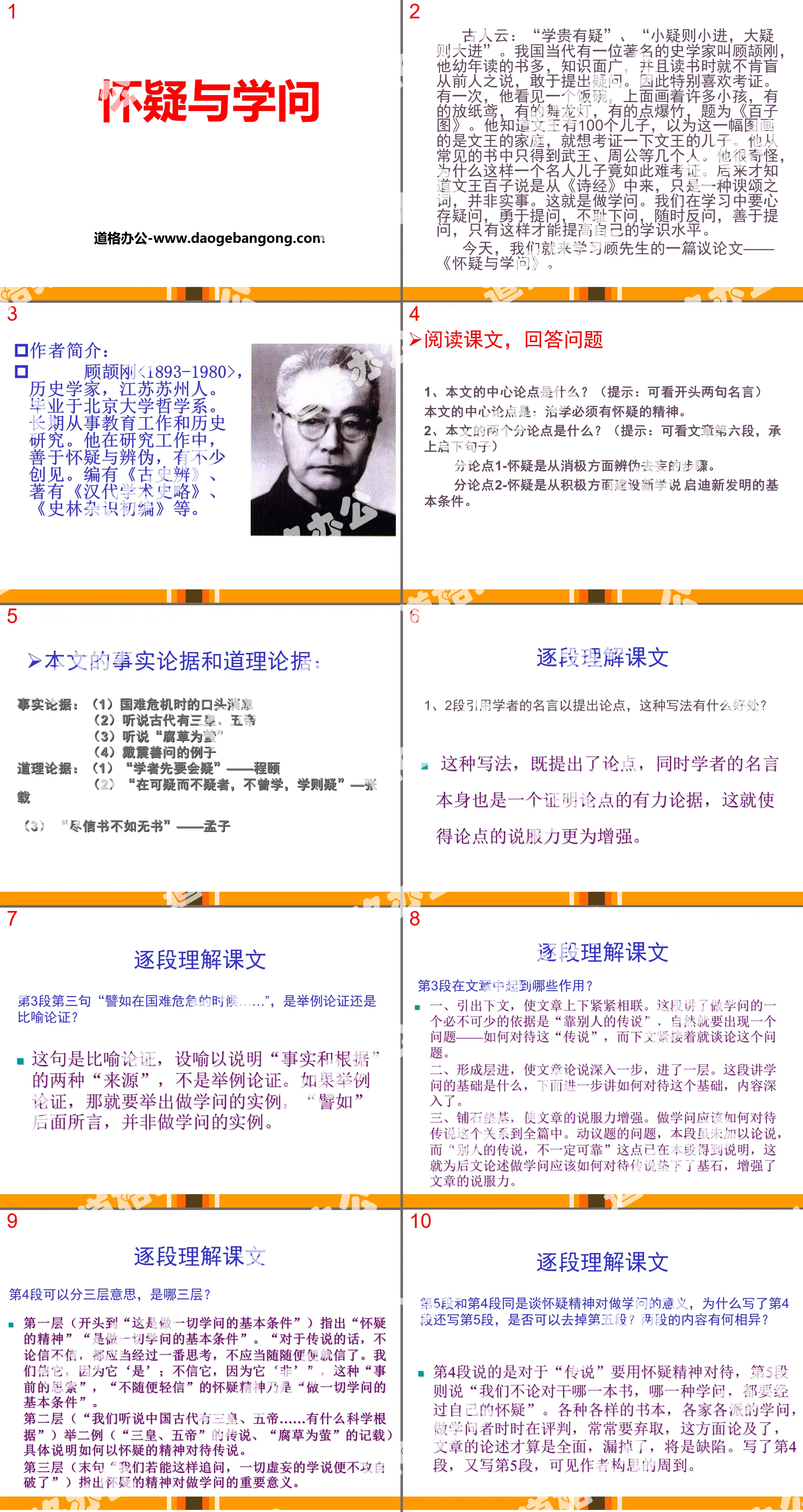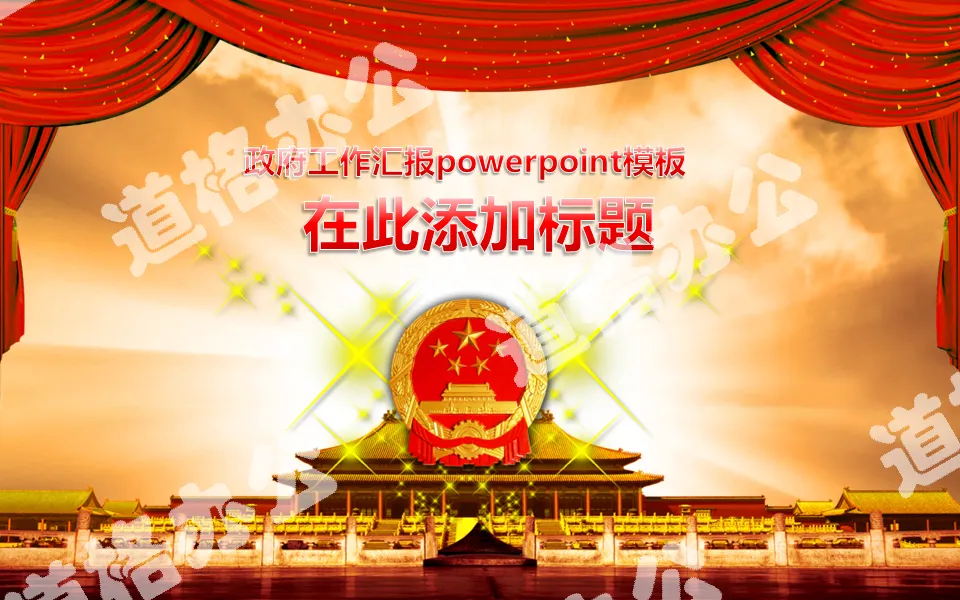
| Category | Format | Size |
|---|---|---|
| E-education edition Chinese language for eighth grade, volume 1 | pptx | 6 MB |
Description
"Doubt and Knowledge" PPT teaching courseware
Contents of the first part: Introduction to the author:
Gu Jiegang <1893-1980>, historian, native of Suzhou, Jiangsu. Graduated from the Philosophy Department of Peking University. He has been engaged in education work and historical research for a long time. In his research work, he was good at doubting and identifying falsehoods, and he had many original ideas. He has edited "Ancient History", "A Brief Academic History of the Han Dynasty", "The Preliminary Collection of Miscellaneous Knowledge of Shilin", etc.
Doubt and Knowledge PPT, Part 2: Read the text and answer the questions
1. What is the central argument of this article? (Tip: You can read the first two famous quotes)
The central argument of this article is: Scholarship must have a skeptical spirit.
2. What are the two sub-points of this article? (Tip: Please read the sixth paragraph of the article to connect the previous and following sentences)
Sub-point 1-Doubt is a step to identify falsehood and eliminate falsehood from the negative side.
Sub-argument 2 - Doubt is the basic condition for building new doctrines and enlightening new inventions from a positive perspective.
The factual and rational arguments of this article:
Factual arguments: (1) Oral messages during national crisis
(2) I heard that there were three emperors and five emperors in ancient times
(3) I heard that "rotten grass is a firefly"
(4) Example of Dai Zhenshanwen
Logical arguments: (1) "Scholars must first doubt" - Cheng Yi
(2) "Those who do not doubt when they are doubtful have never learned, and those who learn will doubt" - Zhang Zai
(3) "It is better to believe in books than to have no books at all" - Mencius
Doubt and Knowledge PPT, Part 3: Understanding the text paragraph by paragraph
Paragraphs 1 and 2 quote famous quotes from scholars to make arguments. What are the benefits of this way of writing?
This way of writing not only puts forward the argument, but also the scholar's famous saying itself is a powerful argument to prove the argument, which makes the argument more persuasive.
In the third sentence of paragraph 3, "For example, in times of national crisis...", is it an example or a metaphor?
This sentence is a metaphorical argument, a metaphor is used to illustrate the two "sources" of "facts and basis", not an argument by example. If you give an example to demonstrate, you have to cite examples of learning. "For example" as mentioned later is not an example of learning.
What role does paragraph 3 play in the article?
1. Lead to the following and make the upper and lower parts of the article closely connected. This paragraph talks about an indispensable basis for learning is "relying on other people's legends". Naturally, a question arises - how to treat this "legend", and this issue will be discussed below.
2. Form a layer-by-layer progression, making the article's discussion go one step further. This section talks about what the foundation of knowledge is. Next, we will further talk about how to treat this foundation. The content is in-depth.
3. Lay the foundation to enhance the persuasiveness of the article. How to treat legends as a scholar is related to the whole article. Although the issue of the motion question is not discussed in this paragraph, the point that "other people's legends are not necessarily reliable" has been explained in this paragraph. This lays the foundation for the subsequent discussion of how scholars should treat legends and strengthens the The persuasiveness of the article.
Paragraph 4 can be divided into three levels of meaning. Which three levels are they?
The first level (beginning with "This is the basic condition for doing all learning") points out that "the spirit of doubt" "is the basic condition for doing all learning." "Whether you believe in a legend or not, you should think about it carefully and should not just believe it casually. We believe it because it is 'yes'; we do not believe it because it is 'not'", this kind of "beforehand" "Thinking" and the skeptical spirit of "not being credulous" are "the basic conditions for all learning."
The second level ("We heard that there were three emperors and five emperors in ancient China...what scientific basis is there?") gives two examples (the legend of "three emperors and five emperors", the record of "rotten grass as firefly") to explain in detail how to use doubtful The spirit treats the legend.
The third level (the last sentence "If we can ask this question, all false theories will be self-defeating") points out the importance of the spirit of doubt in learning.
Paragraphs 5 and 4 both talk about the significance of skepticism to learning. Why do you write paragraph 5 instead of paragraph 4? Can the fifth paragraph be deleted? What is the difference between the contents of the two paragraphs?
Paragraph 4 says that "legends" should be treated with suspicion, while paragraph 5 says that "no matter which book or knowledge we study, we must go through our own doubts." There are all kinds of books and knowledge from various schools. Scholars are always judging and often rejecting. Only when this aspect is discussed can the article's discussion be considered comprehensive. If it is omitted, it will be a flaw. I wrote the 4th paragraph and then the 5th paragraph, which shows the author's thoughtfulness.
Doubt and Knowledge PPT, Part 4: Induction Center
After an argumentative essay puts forward an argument, it often uses a combination of principles and examples to develop the argument, so that it is persuasive.
This article discusses the view that scholars must first be skeptical, and to learn from doubt, it emphasizes the important role of the spirit of skepticism in the process of scholarship, and advocates that scholars should have a spirit of skepticism and not blindly follow or be superstitious. This article revolves around the central argument and sets up two sub-arguments, which are discussed in a hierarchical manner with clear organization and a clear center. This argument structure and method is worth learning by students.
Doubt and Knowledge PPT, Part 5: Think About It
Without doubt, there is no new knowledge
"Studying is expensive but doubtful." The famous scientist Li Siguang also said: "Without doubt, you cannot see the truth." In study and life, you must have had the experience of gaining new knowledge due to doubt. Please choose a meaningful example and write a paragraph
Keywords: Free download of Chinese PPT courseware for the first volume of the eighth grade of the E-education edition, download of Doubt and Knowledge PPT, .PPT format;
For more information about the "Doubt and Knowledge" PPT courseware, please click on the Doubt and Knowledge ppt tab.
"Doubt and Knowledge" PPT courseware (second lesson):
"Doubt and Knowledge" PPT courseware (second lesson) Part 1: 1. Explanation of the new lesson Paragraph 4 has three levels of meaning. Which three levels are they? The first level (the beginning is also the basic condition for doing all knowledge): Pointing out that the spirit of doubt is the basic condition for doing all learning. No..
"Doubt and Knowledge" PPT courseware (first lesson):
"Doubt and Knowledge" PPT courseware (first lesson) The first part of the content: 1. The new lesson introduces Galileo's doubts about Aristotle's views, so he came up with the law of free fall; Watt because there was water boiling, the pot I wondered why Gai jumped up and found out...
"Doubt and Knowledge" PPT courseware download:
"Doubt and Knowledge" PPT courseware download Part One: Learning Objectives 1. Learn how to set up a hierarchical discussion of sub-arguments around the central argument of this article. 2. Learn how this article is discussed through examples, principles and comparative argument methods; learn these argument methods..
File Info
Update Time: 2024-07-29
This template belongs to Chinese courseware E-education edition Chinese language for eighth grade, volume 1 industry PPT template
"Doubt and Knowledge" PPT teaching courseware Simple campus recruitment activity planning plan summary enterprise and institution recruitment publicity lecture PPT template is a general PPT template for business post competition provided by the manuscript PPT, simple campus recruitment activity planning plan summary enterprise and institution recruitment promotion Lecture PPT template, you can edit and modify the text and pictures in the source file by downloading the source file. If you want more exquisite business PPT templates, you can come to grid resource. Doug resource PPT, massive PPT template slide material download, we only make high-quality PPT templates!
Tips: If you open the template and feel that it is not suitable for all your needs, you can search for related content "Doubt and Knowledge" PPT teaching courseware is enough.
How to use the Windows system template
Directly decompress the file and use it with office or wps
How to use the Mac system template
Directly decompress the file and use it Office or wps can be used
Related reading
For more detailed PPT-related tutorials and font tutorials, you can view: Click to see
How to create a high-quality technological sense PPT? 4 ways to share the bottom of the box
Notice
Do not download in WeChat, Zhihu, QQ, built-in browsers, please use mobile browsers to download! If you are a mobile phone user, please download it on your computer!
1. The manuscript PPT is only for study and reference, please delete it 24 hours after downloading.
2. If the resource involves your legitimate rights and interests, delete it immediately.
3. Contact information: service@daogebangong.com
"Doubt and Knowledge" PPT teaching courseware, due to usage restrictions, it is only for personal study and reference use. For commercial use, please go to the relevant official website for authorization.
(Personal non-commercial use refers to the use of this font to complete the display of personal works, including but not limited to the design of personal papers, resumes, etc.)
Preview




















